Tracey Warr's Blog, page 12
January 11, 2022
A contemporary troubadour
I’ve just interviewed J.K. Knauss for the launch of her new collection of medieval stories, Our Lady’s Troubadour. The interview is posted on the Historical Novel Society webpage. We talked about how the author worked with her medieval source material, about the relationship between historians and historical novelists, and about her writing group.
‘ I got into historical fiction because in grade school, there was a timeline on our classroom wall that began with Leif Eriksson being born in 970. It blew my mind that people lived so long ago. I wanted to know what it was like to see, hear, smell, and taste the world at that time, and what it felt like to experience all that. This visceral involvement is historical fiction’s legitimate goal.’
You can find J.K.’s fascinating interview here.
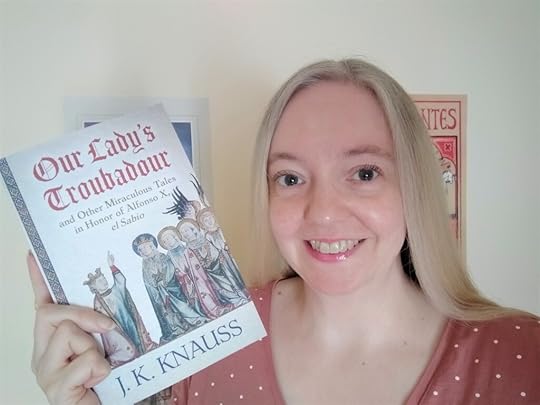
I am part of the team running sponsored interviews for the Historical Novel Society. For a small fee authors or their publishers can request an interview. The team started work last year and we have so far published over 30 interviews with authors launching new books. The interviews are full of useful tips on writing techniques and behind the scenes information for readers. We also ask each interviewee to tell us what was the best book you read recently, so lots of ideas for reading with the launch books themselves and the author’s suggestions. If you have a book coming out you can request an interview here.
We have just launched a new Instagram site for the HNS Interviews.
December 21, 2021
Planning a Novel 2: Envisaging Characters
In planning my latest novel, I’m now moving on to envisaging characters. I’ve created a ‘character book’, with a page on each of them visualising what they look like, their back stories, their motivations.
Some of my characters are real historical people where there is information known about at least the basic events of their lives. Other characters are entirely fictional. To visualise them, I look at paintings – not so much medieval paintings, which were quite formulaic and naïve in terms of portraits. Instead, I look at portraits from the Renaissance– Sofonisba Anguissola, Parmigianino, Botticelli, and from later periods: Whistler and others. I look at photos of film and tv actors who seem to me to evoke something of my characters. Then I see people on the street or on a train, or I use people I know. My characters are visualised with a mix of all those sources. Envisaging the characters helps me write with them. I won’t give you the images I’m using because readers will want to envisage the characters themselves. Each reader will see the characters differently, based on their own imagination and associations, combined with my descriptions.
Book covers present a dilemma in this regard. For a long time, it was the trend to feature a headless woman or a woman with her face turned away on the covers of historical fiction focused on a female protagonist, to allow readers to imagine the character themselves. My first novels, Almodis and The Viking Hostage are examples of that style.
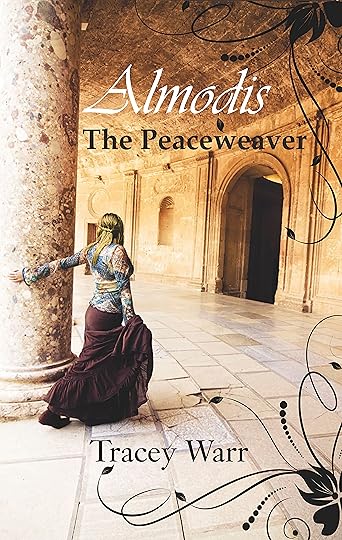

Recently, there have been more full-face historical fiction covers, like my own Conquest series. Do you have a view on this? Do you like covers that picture the protagonist or prefer a less proscriptive image of a character on a book cover?
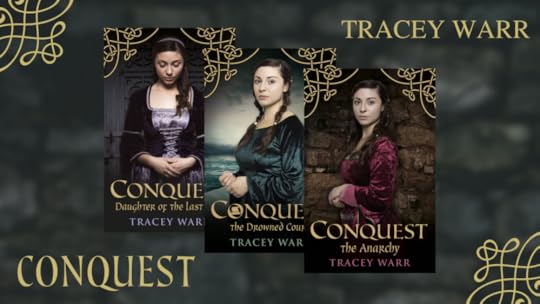
[Title image is Parmigianino’s Pallas Athene, 1539]
December 19, 2021
Planning a Novel 1: Mapping and Settings
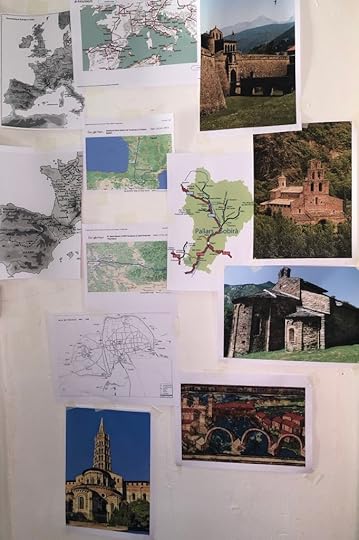
Novel planning in progress. I don’t have a lot of study wall space but what there is is starting to fill up! Above – locations and maps for the key settings and journey from medieval Toulouse, to Pallars Sobira in the Pyrenees, and the Iberian kingdom of Aragon.
Moving upwards images are San Sernin in Toulouse; Chateau Narbonnais and bridge across the Garonne, Toulouse; the chapel of Sant Pere del Burgal in Pallars Sobira; the abbey of Santa Maria de Gerri de Sal in Pallars Sobira and Jaca in Aragon.
Next, I’m working on a gallery of characters and a timeline. Contexts I’m researching for the novel include the development of the pilgrim route to Santiago de Compostella, the lucrative medieval salt trade, power struggles among the Occitan and Catalan nobility, and the pressure for both church and secular reform coming from the Pope.
Novel in progress

Novel planning in progress. I don’t have a lot of study wall space but what there is is starting to fill up! Above – locations and maps for the key settings and journey from medieval Toulouse, to Pallars Sobira in the Pyrenees, and the Iberian kingdom of Aragon.
Moving upwards images are San Sernin in Toulouse; Chateau Narbonnais and bridge across the Garonne, Toulouse; the chapel of Sant Pere del Burgal in Pallars Sobira; the abbey of Santa Maria de Gerri de Sal in Pallars Sobira and Jaca in Aragon.
Next, I’m working on a gallery of characters and a timeline. Contexts I’m researching for the novel include the development of the pilgrim route to Santiago de Compostella, the lucrative medieval salt trade, power struggles among the Occitan and Catalan nobility, and the pressure for both church and secular reform coming from the Pope.
November 27, 2021
Murder, lies and art
 Sant Pere del Burgal in the Pyrenees, which housed important frescos
Sant Pere del Burgal in the Pyrenees, which housed important frescosCurrently researching for the medieval murder mystery I’m writing and discovering that the range of potential murderous motives at the end of the 11th century in the Toulouse/Pyrenees area are legion.
The establishment of the lucrative pilgrim route to Compostela; the salt trade; papal policy over reform, reconquest in Spain and pressure on aristocratic consanguineous marriages, adultery and simony; power struggles between Toulouse and Aquitaine and between the Christian rulers of northern Spain are all contenders for a murder motive. It is juicy stuff, providing plenty of potential red herrings as well as the real reason for the murder.
There is also masses of interesting art history and poetic tradition to delve into, which is always part of my writing – with cathedral building, chapel frescos and the troubadours.
 The chapel of Santa Maria de la Serra in the Pyrenees
The chapel of Santa Maria de la Serra in the Pyrenees
 Santa Eulalia d’Alendo, Pyrenees
Santa Eulalia d’Alendo, PyreneesThe title image is Santa Maria de Gerri de la Sal in the Pyrenees, which profited from a nearby salt mine.
November 16, 2021
Reading and Writing
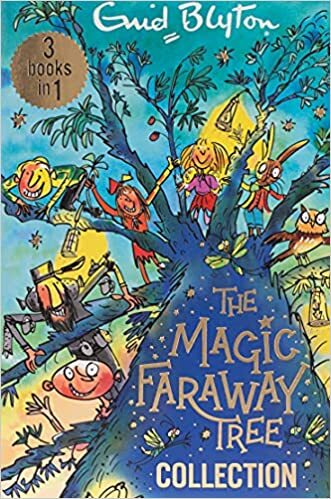
Last week, reading Enid Blyton’s The Magic Faraway Tree to my two grandsons, age five and two weeks, made me realise why I write fiction myself. My five-year-old grandson has just started reading. It is so exciting to see him doing that after literally five years of his mum and me reading him three stories every night at bedtime. It feels like a miracle to see someone start to read. I write because I love to read, and I want to be creating that joy for other people. Enid Blyton is, of course, a throw-back to my own childhood reading (in a treehouse built by my dad, in a holly tree).
I’m still working away hard at NanoWriMo – national novel writing month – a challenge to write 50,000 words in 30 days. I’m a little behind the target but still I have words, I have momentum, I have enthusiasm again for my own writing, so I expect to reach the finishing line with 50,000 words. See my previous posts for more on NanoWriMo and the medieval murder mystery I am working on.
This photo, taken last week by my daughter, of me reading...
This photo, taken last week by my daughter, of me reading Enid Blyton’s The Magic Faraway Tree to my two grandsons, age five and two weeks, made me realise why I write fiction myself. My five-year-old grandson has just started reading. It is so exciting to see him doing that after literally five years of his mum and me reading him three stories every night at bedtime. It feels like a miracle to see someone start to read. I write because I love to read, and I want to be creating that joy for other people. Enid Blyton is, of course, a throw-back to my own childhood reading (in a treehouse built by my dad, in a holly tree).
I’m still working away hard at NanoWriMo – national novel writing month – a challenge to write 50,000 words in 30 days. I’m a little behind the target but still I have words, I have momentum, I have enthusiasm again for my own writing, so I expect to reach the finishing line with 50,000 words. See my previous posts for more on NanoWriMo and the medieval murder mystery I am working on.
November 7, 2021
Writing a medieval murder mystery
I am on Day 7, at the end of week 1 of the NanoWriMo challenge to write 50,000 words in the 30 days of November. See my earlier post on starting the challenge and a second post on my writing playlist.
If I were going to write the same number of words on each of the 30 days of this month I would need a daily word count of 1,667. I’m woefully behind that at the moment because of the amount of research I have to do to write one word, one sentence, to have a sense of the characters and their social and political context. I spent a day, for example, deciding what instrument my protagonist, a female Catalan troubadour called Beatriz, would play. I settled on the vielle. (The title image opposite is a vielle player in the Peterborough Psalter.)
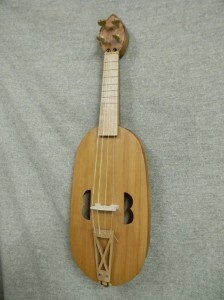
For this, my sixth historical novel, I’ve decided to write a murder mystery (the first in a long-running series featuring Beatriz ). I was stuck for a long time on the murder mystery aspect of plotting the novel – what are the motives for the murder, how do I gradually uncover those motives and the murderer?
Despite my halting start this month I am getting somewhere. The layers of potential motives and the possible murderers are clarifying in my mind so I’m hoping I will get more of a sprint on later in the month and hit the 50,000 words target. Political marriages, power plays between the nobles of southern France and northern Spain and between the church and those nobles, simple greed, papal machinations, sheer murder lust, and the lucrative medieval trades in salt, pilgrimage routes, and relics are all in the cauldron and it’s starting to brew now.
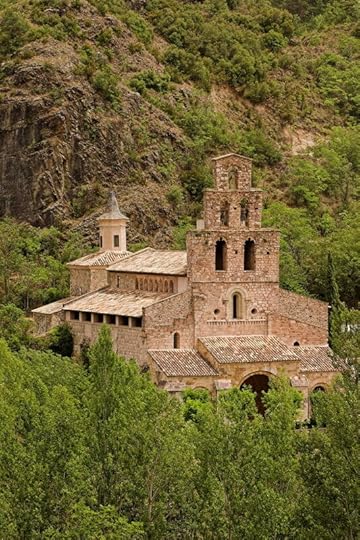 The monastery of Santa Maria de Gerri de la Sal in the Pyrenees, with its wealth built partly on the nearby salt mine
The monastery of Santa Maria de Gerri de la Sal in the Pyrenees, with its wealth built partly on the nearby salt mineThe novel is set at the end of the 11th century in Toulouse, the Pyrenees, Aragon and Poitiers. There was a great deal of social transition going on at that time with changes in inheritance/succession customs, church reform and interference in the affairs of the nobility, the reconquest efforts in Spain against the Muslim kingdoms. Lots of lovely complexity to work with!
I am collecting my visual research at this Pinterest board.
November 2, 2021
Medieval novel playlist
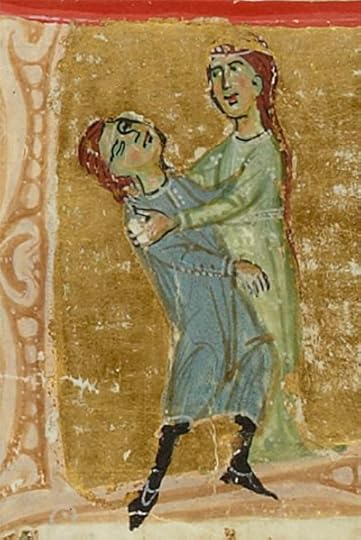 The troubadour Jaufre Rudel dies in the arms of Hodierna of Tripoli, his ‘love from afar’, 13th century illumination, public domain, via Wikimedia
The troubadour Jaufre Rudel dies in the arms of Hodierna of Tripoli, his ‘love from afar’, 13th century illumination, public domain, via WikimediaI’m currently undertaking NanoWriMo November – aiming to write 50,000 words of my new novel about a female troubadour (or trobairitz). NanoWriMo asked for a playlist for my novel so here it is:
The working title for my novel, A Morsel of Love’s Bread, is taken from a line in the troubadour poem, ‘Ab la dolchor del temps novel’ (‘In the sweetness of this new season’) by Guillaume IX Duke of Aquitaine, who is one of the characters in my novel. The full phrase in the poem is ‘A morsel of love’s bread, and its knife’.
The following playlist includes a performance of ‘Ab la dolchor’, two performances of a trobairitz (female troubadour) poem and a selection of troubadour songs. My protagonist is a trobairitz named Beatriz. These videos also show Beatriz’s instrument, the vielle, and other medieval instruments and female singers in action.
Beatriz, Countess of Dia, ‘A chantar m’er de so qu’eu no volria’ (‘Of things I’d rather keep in silence I must sing’) performed by Galdra, 8.25 mins
Guillaume Duke of Aquitaine, ‘Ab la dolchor del temps novel’ (‘In the sweetness of this new season’) performed by Hamid Khezri & Caroline Dufau, 3.54 mins
Songs of the Troubadours performed by Ensemble Celadon, 5.17 mins.
Beatriz, Countess of Dia, ‘A chantar m’er de so qu’eu no volria’ (‘Of things I’d rather keep in silence I must sing’) performed by Jordi Savall, 8.24 mins
October 31, 2021
Joining NanoWriMo November
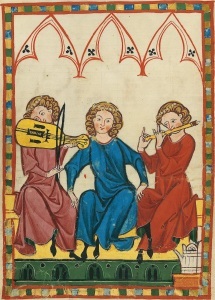 Musicians from the 14th century Codex Manesse. Wikimedia.
Musicians from the 14th century Codex Manesse. Wikimedia.Since I’ve had a writer’s block for over a year, I decided to sign up to NanoWriMo November and see if this could help kick me into a place with a substantial new novel draft to work with.
National Novel Writing Month began in 1999 as a challenge to write 50,000 words of a novel in thirty days. Now, each year on November 1, hundreds of thousands of people around the world begin to write, determined to end the month with 50,000 words. Last year, 552,335 writers participated in NanoWriMo.
My project is a new historical novel set in 12th century France and Spain. Its working title is A Morsel of Love’s Bread (a line from a poem by the troubadour duke, Guillaume of Aquitaine). I’ve made several false starts on the manuscript of this novel over the last year and am hoping that I can get it underway and put my writer’s block behind me. I will be logging my progress here and on my profile on the NanoWriMo site.
Let me know if you are also participating in NanoWriMo.



